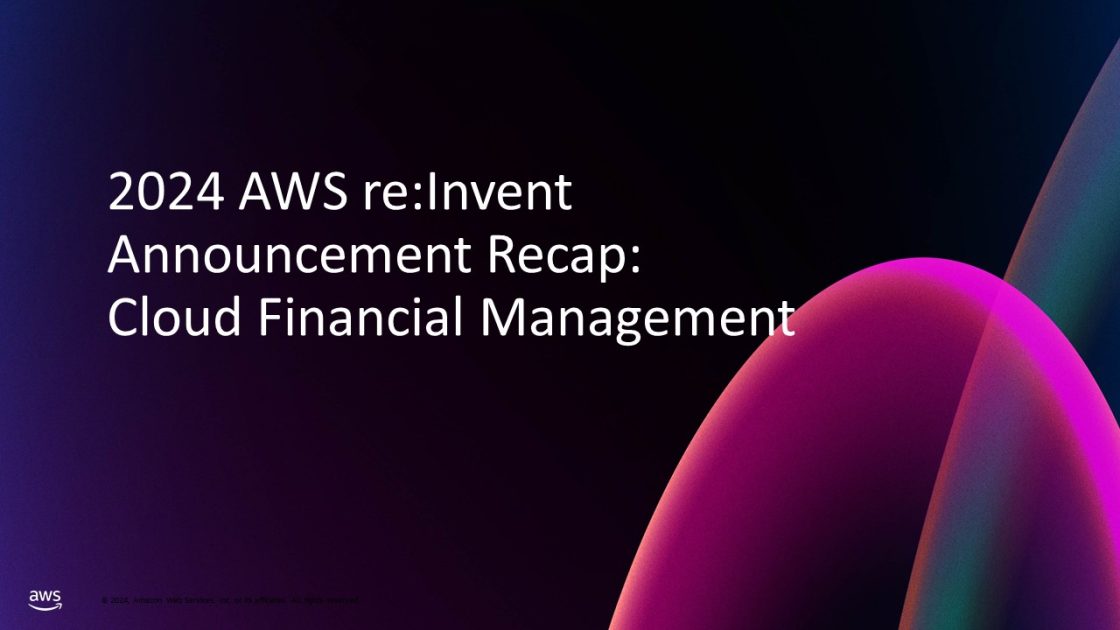- Siraj Finance partners with Azentio
- Half of people with housing costs ‘starting 2025 worried about home or finances’
- Industry majors, authorities gather at Turkuvaz to discuss ‘future of finance’
- Why They Should Be on Your Radar
- Analysts expect the usual ‘Santa Claus rally’—but watch out if it doesn’t arrive
I have been putting off writing a summary of all the announcements our Cloud Financial Management (CFM) team made at 2024 re:Invent. My procrastination is partly due to the holiday preparations like many of you. However, more importantly, I’ve been waiting for one more announcement. Now, with great pleasure, I am happy to share with you the ten features recently added to the AWS CFM portfolio of services. While we may not achieve a perfect 10, as there is always room for improvement, we do hope that these ten new features will help accomplish your daily FinOps tasks more effectively.
You are viewing: 2024 re:Invent announcement recap for AWS Cloud Financial Management services
To better align these new features with the common use cases you typically engage with, I will introduce them to you organized by the four solution areas outlined in the AWS Cloud Financial Management framework.
Plan & Evaluate
1) Authenticated, in-console AWS Pricing Calculator: for those of you who want to estimate cost impact of resource changes, such as migrating to a new region, adding or removing resources to existing workloads, you can now log into AWS Pricing Calculator with your account information. This means you can easily pull up your existing usage details, make modifications, and take into consideration of your discounts. You can simulate an entire bill computation by including cost impact analysis to workload and purchase option changes (e.g., Reserved Instances, Savings Plans). Learn more from this blog post.
2) Savings Plans Purchase Analyzer: Speaking of simulating cost analysis for purchase option changes, you can now conduct a quick analysis for Savings Plans purchases with your own hourly commitment amount. The same feature also gives you the option to customize lookback period so you are more intentional of what historical data you want the analyzer to use. You can also choose to remove Savings Plans that are expiring in the next 90 days to prepare for renewal ahead of the time. Learn more from this blog post.
Track and Allocate
3) Custom Billing View: we often say “you can’t improve what you can’t measure”. This is very true when it comes to cloud cost efficiency. As the FinOps leaders, you centrally develop the strategies, policies, and KPI targets. However, you know these can only be implemented if your teams have the right level of visibility into their cost and usage. Now, you can create a custom view with Cost Allocation Tags and accounts in AWS Cost Explorer that only displays cost and usage information relevant to your stakeholders, such as application owners, business unit leaders. Learn how you can create that custom billing view and our recommended best practices in this blog post. FYI. This is the last announcement I was referring to.
See more : PrimeRevenue Wins 2025 Global Finance Award
Figure 1. Sample screenshot shows billing view under cost management preference
4) Data Exports for FOCUS 1.0 with AWS Columns (GA): AWS is a proud premier member of the FinOps Foundation. One of the key initiatives the foundation is advancing is FOCUS, aiming to help you normalize cost and usage data across different sources. We announced the preview version back in June at FinOps X. Now with the general availability release, we have improved the data accuracy and conformance against the FOCUS 1.0 specifications. We encourage you to start using the export to find insights for your cloud investment across various areas. Details can be found in this blog post.
5) GenAI powered cost analysis in Amazon Q: we know not everyone in your organization is familiar with AWS Cost Explorer or Cost and Usage report. Now you can ask and get cost analysis questions answered in natural language via Amazon Q. You can access Q anywhere in AWS Console and perform many basic cost analysis: e.g., month over month changes, cost driver, forecasted cost, cost by Cost Categories or Cost Allocation Tag. What can be helpful for you is that for each response, there will be a deep link to Cost Explorer to visualize the analysis. Read more from this blog.
6) Amazon EKS pod-level cost and usage data with Split Cost Allocation Data: access to granular cost and usage data for shared resources is fundamental for allocating cost at your desired level. Therefore, we start investing in Split Cost Allocation Data spring 2023. Currently you can opt in to receive split cost allocation data for Amazon ECS and Amazon EKS in your Cost and Usage report. You will have EC2 instance cost distributed at ECS task level and EKS pod level. When configuring for EKS, you can choose to have us calculate and allocate EC2 cost based on your resource request, or CPU and memory utilization metrics through Amazon Managed Service for Prometheus, or the newly launched support for Amazon CloudWatch Container Insights.

Figure 2. Sample screenshot of Split cost allocation data opt-in under the cost management preference
Optimize and Save
7) Idle resource detection and cleanup recommendation: clean up idle resources can be an easy win for your organization to start seeing results in your FinOps initiatives. Now, you can get idle resource detection and clean up recommendations in AWS Compute Optimizer and Cost Optimization Hub for idle Amazon EBS volumes, Amazon ECS tasks running on Fargate, Amazon EC2 instances, Amazon EC2 Auto Scaling groups, and Amazon RDS instances. See how we define these idle resources and what recommendation details you can get from this blog.
See more : Survey the Damage, Take Action, and Start the New Year on a Strong Financial Footing
8) Amazon Aurora Rightsizing recommendations: for those of you who run your database instances on Amazon Aurora MySQL-compatible and PostgreSQL-compatible engines, you will now see idle instances detection and rightsizing recommendations for you to migrate to graviton, upgrade to latest generation hardware, and improve your overall workload performance.

Figure 3. Sample screenshot of Amazon Aurora rightsizing recommendations in Amazon Compute Optimizer
Govern and Operate
9) Enhanced root cause analysis for Cost Anomaly Detection: many of you have told us that Cost Anomaly Detection gives you great insights in potential causes for anomalous spend. The service looks at your net unblended cost and alerts you when the actual spend exceeded the expected daily spend. Now with each anomaly detected, you will receive an analysis with up to 10 potential root causes with approximate dollar impact to your anomaly. You can review the analysis across dimensions of region, service, account, and usage type. More details can be found in this blog.
10) Invoice configuration: this launch is uniquely beneficial to those of you who want individual business entities to be responsible for their own spend and payment. It saves you time from manually splitting AWS invoices and separates your invoices at the individual invoice unit level that you configure yourself. Member accounts still receive benefits from the organization, e.g. volume discounts, purchase option benefits. Read more details on how you can achieve this flexibility from this blog.
Conclusions
And there you have it – an overview of all ten features newly added to the AWS Cloud Financial Management portfolio of services. These new features are like our holiday gifts to you. We hope you enjoy your holiday and these special gifts from us. We look forward to hearing about your experiences with them.
Source link https://aws.amazon.com/blogs/aws-cloud-financial-management/2024-reinvent-announcement-recap-for-cloud-financial-management-services/
Source: https://summacumlaude.site
Category: News







